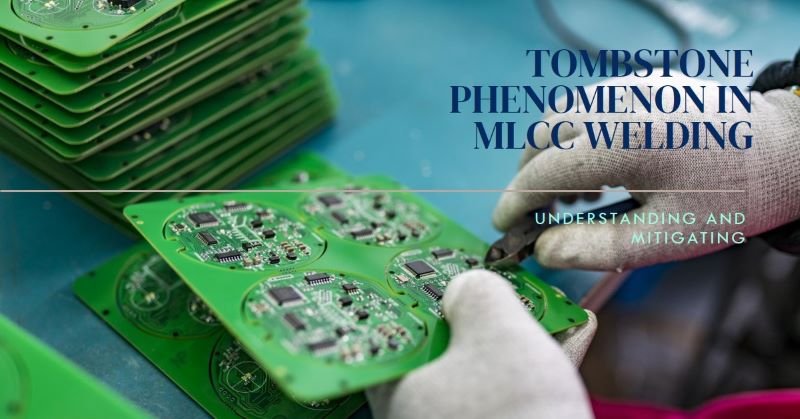Understanding and Mitigating the Tombstone Phenomenon in MLCC Welding
The tombstone phenomenon, also known as the suspension bridge phenomenon. It is a significant challenge in the welding process of Multi-layer Ceramic Capacitors (MLCC) to Printed Circuit Boards (PCB). This issue arises when one end of the MLCC detaches from the welding area and stands upright or inclines, resembling a tombstone. The primary cause of this phenomenon is the unbalanced wetting force at the MLCC’s ends during the welding process.
What is PCB Tombstone?
PCB tombstone is a notable defect encountered in the electronics manufacturing process, particularly during the soldering phase. It derives its name from the characteristic appearance of passive components, such as resistors or capacitors, which stand upright on one end, resembling a tombstone. This phenomenon occurs when there is an imbalance in the wetting forces during soldering, causing one end of the component to lift from the pad. Consequently, the component fails to achieve a proper connection with the printed circuit board (PCB), leading to potential malfunctions.
The occurrence of PCB tombstone can have significant implications for the functionality and reliability of electronic devices. Components that exhibit this defect may not form reliable electrical connections, resulting in circuit failures or intermittent connections. This is particularly critical in high-reliability applications, such as medical devices, aerospace, and automotive electronics, where any form of malfunction can have severe repercussions.
Addressing PCB tombstone defects is crucial in the manufacturing process to ensure the performance and longevity of electronic products. Manufacturers must implement stringent quality control measures and optimize their soldering processes to minimize the risk of tombstoning. By understanding the causes and implications of this defect, manufacturers can take proactive steps to enhance the reliability of their PCBs and, by extension, the performance of the final electronic products.
Causes of the Tombstone Phenomenon
1. Asynchronous Melting of Solder Paste
One key factor is the failure of solder paste at both ends of the MLCC to melt simultaneously. This leads to uneven surface tension and solder adhesion, which can cause one end to lift or the entire MLCC to tilt.
2. Unreasonable Pad Design
Poorly designed pads can exacerbate the imbalance in wetting forces. Pads of different sizes or asymmetrical layouts can lead to inconsistent solder paste melting times and surface tension forces, contributing to the tombstone effect.
Types of MLCC Movement Due to Uneven Wetting
1. Self-alignment

During the solder paste printing process, the MLCC is placed on the pad using an automatic placement machine. If the solder paste at both ends melts simultaneously, the uniform tin-dipping force can pull the MLCC back into its correct position, correcting any minor misalignment (Figure 1). Modern placement machines can adjust the X, Y, and θ coordinates to reduce pre-welding deflections.
2. Skewing

When the solder joints melt at different times or with different intensities, the MLCC can be pulled diagonally (Figure 2). In some cases, one end may be completely pulled towards itself, leading to a weak solder joint at the other end (Figure 3).
3. Tombstoning

The most severe case occurs when the tin-dipping forces at both ends are highly unbalanced. This imbalance can erect the MLCC, forming a tombstone phenomenon.
Preventative Measures
1. Simultaneous Welding at Both Ends
To mitigate the tombstone effect, it’s crucial to ensure that both ends of the MLCC are welded simultaneously. Rapid welding can minimize the time difference in solder melting, reducing the likelihood of one end lifting due to surface tension and tin-dipping forces (Figures 4 and 5).
2. Reasonable Pad Design
A well-designed pad can prevent tombstoning by ensuring consistent wetting forces. Key design considerations include:
- Ensuring the overlap length of the MLCC metal end and the solder pad is at least 0.3 mm.
- Minimizing the pad space to be just enough to be filled with tin, typically not exceeding 0.5 mm.
- Keeping the pad width reasonable, generally not exceeding 0.25 mm compared to the MLCC width.
3. Maintaining Solder Paste Activity
Solder paste is sensitive to contamination, oxidation, and moisture absorption. To maintain its effectiveness:
- Store solder paste in a controlled environment (5-10°C).
- Allow solder paste to reach room temperature before use to prevent condensation.
- Stir solder paste thoroughly before application.
- Avoid exposing unused solder paste to air to prevent deterioration.
- Store leftover solder paste separately from fresh paste to avoid contamination.
- Ensure a stable working temperature by keeping the solder paste printing process away from frequently opened doors and windows.
4. Keeping MLCC Surfaces Clean
Contaminated MLCC surfaces can lead to poor wetting and tombstone phenomena. Both MLCC manufacturers and users should implement anti-fouling measures to ensure surface cleanliness. Figures 6 and 7 illustrate the difference in wetting behavior between contaminated and uncontaminated MLCC surfaces, highlighting the importance of maintaining cleanliness.
Conclusion
In conclusion, Addressing the tombstone phenomenon requires a multifaceted approach that includes ensuring simultaneous solder melting, designing reasonable pads, maintaining solder paste activity, and keeping MLCC surfaces clean. Implementing these measures can significantly reduce the incidence of tombstoning, enhancing the quality and reliability of printed circuit boards and reducing manufacturing costs.
